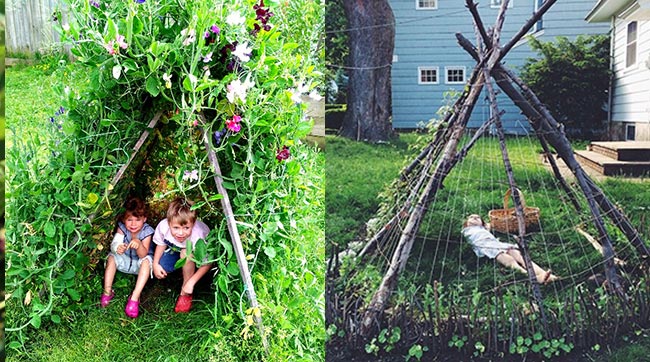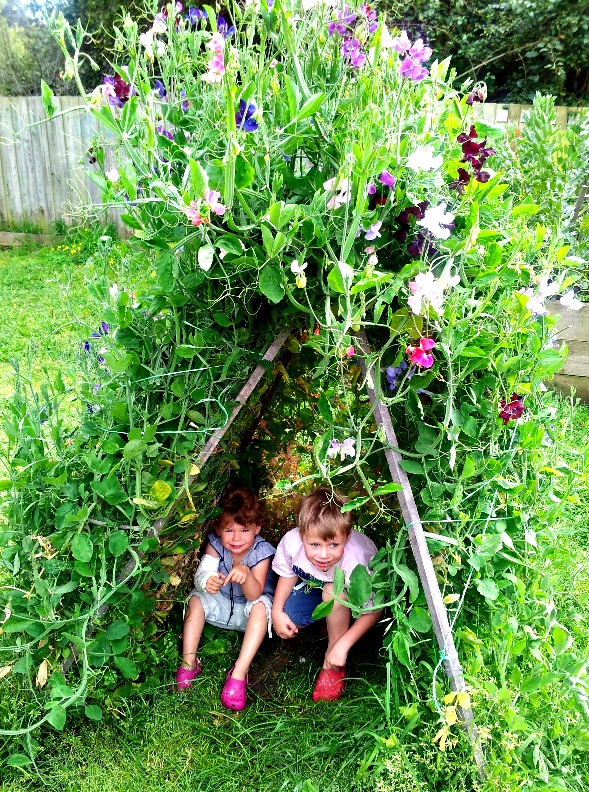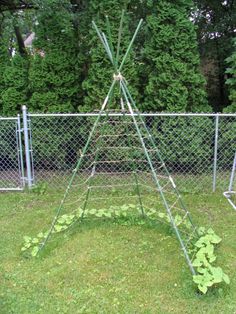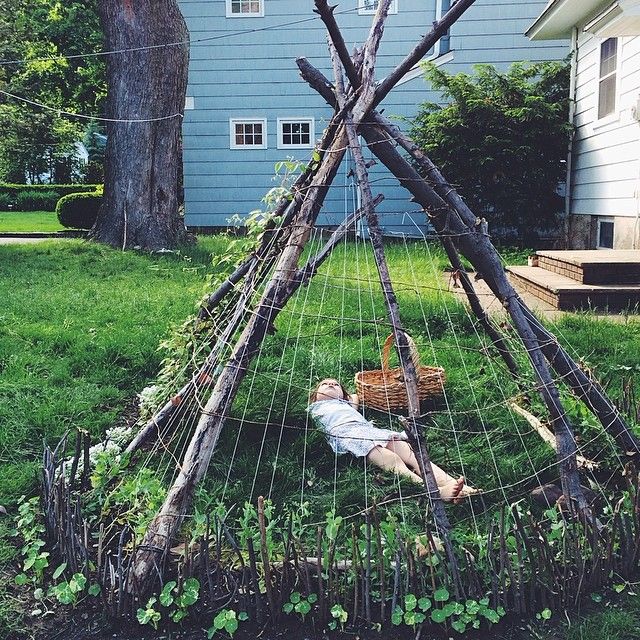Creating a Green Secret Garden: How to Build a Natural Teepee with Climbing Plants
Creating your own little people’s summer hideout is a delightful and rewarding project that brings together nature, creativity, and family fun. Whether you’re working with a small balcony, a spacious garden, or a cozy lawn, this hands-on garden project provides an enchanting space for both children and adults to enjoy the great outdoors. Think of it as an edible, fragrant, and visually stunning retreat where you and your little ones can gather, explore, and marvel at the wonders of nature. Easy to make, yet endlessly rewarding, this garden structure will not only give your garden a whimsical touch, but it will also invite you and your family to spend more time outdoors. Let’s dive into how to craft a bigger and better version of the classic bean tee-pee by expanding the variety of plants and offering a true multi-sensory experience.

Materials You’ll Need:
- 5 to 8 long poles (Bamboo works well for its durability and natural aesthetic, though any sturdy wood can be used)
- String, twine, or rubber connectors (for securely tying the poles together at the top)
- Garden netting or additional string (to weave between the poles and give climbing plants a structure to latch onto)
- A variety of climbing seeds (edible, fragrant, and colorful!)
- Sweet Pea flowers (for their stunning beauty and fragrance)
- Nasturtium flowers (vibrant, edible, and easy to grow)
- Pole beans (a classic and nutritious choice)
- Snap peas or shelling peas (perfect for snackable harvests)
- Morning glories or climbing cucumbers (to add extra color and function)
Step-by-Step Instructions

Step 1: Prepare Your Garden Bed or Container
Whether your hideout is going in your backyard, on a lawn, or even on a balcony, the first step is always to prepare your soil. This is key to ensuring your plants have a healthy, thriving environment.
- For Lawns: If you’re working directly on grass, start by removing the grass where the poles will go. Use a shovel or garden spade to cut out the turf, and then dig in some compost to improve the soil quality. A little lime can be added if your soil is acidic.
- For Garden Beds: Mix in plenty of compost or organic matter to enrich the soil. For any new seedbed, this step will make the planting area nutrient-rich and welcoming to your plants.
- For Containers: If you’re working with containers (perfect for smaller spaces or balconies), ensure you use a high-quality potting mix and consider adding slow-release fertilizer to give your plants a boost throughout the growing season.
Step 2: Set Up Your Tee-Pee Structure

Now comes the fun part—setting up the physical structure of your hideout. This is the frame that will support your climbing plants and provide a sheltered nook in the center.
- Arrange the Poles: Begin by placing your poles in a circle, spacing them evenly apart. The ideal diameter for your tee-pee should be large enough for a few little adventurers to sit comfortably inside, so aim for about 3 to 4 feet wide.
- Tie the Tops Together: Use your twine, string, or rubber connectors to tie the tops of the poles securely. You want the structure to be stable enough to support climbing plants as they grow. If you’re using rubber connectors, they can be found at most garden centers and make the task easier. For a rustic look, simple twine can add a charming, earthy touch.
- Add Netting or String for Climbing: To ensure your plants have a sturdy structure to climb, drape netting or strong garden string between the poles. This will create a lattice effect, allowing vines to latch on as they grow and providing more surface area for your climbing plants.
Step 3: Choose Your Climbing Seeds

With your tee-pee structure in place, it’s time to pick your plants. The idea here is to create a lush, multi-layered hideout that offers beauty, fragrance, edibility, and shade. Here’s a closer look at the best plant choices:
- Sweet Peas: Known for their elegant flowers and sweet fragrance, sweet peas are an ideal choice for this project. Not only do they make the perfect addition to any bouquet, but they also attract pollinators like bees and butterflies. Sweet peas come in a range of colors—from deep purples to soft pinks—and their scent is unmistakable. I recommend using heritage varieties, such as ‘Matacuna,’ which are particularly fragrant and hardy. Plus, you can snip them throughout the summer to keep the flowers coming.
- Nasturtiums: These colorful, edible flowers are a real treat, offering vibrant hues of orange, red, and yellow. Nasturtiums have large, round leaves that will provide wonderful shade and a sense of privacy within your hideout. They’re also easy to grow and attract beneficial insects like ladybugs. Both the leaves and flowers are edible and can be used to garnish salads or make a zesty addition to meals. The vines will happily spread across the ground or climb up your tee-pee structure, adding an extra layer of beauty and functionality.
- Pole Beans & Runner Beans: These classic climbers are not only perfect for creating a green wall around your hideout, but they also provide fresh, delicious snacks. Scarlet Runner beans, with their vivid red flowers, are particularly eye-catching. Though their beans are not typically eaten in large quantities, they’re perfect for a quick nibble right off the vine. My personal favorite are purple pole beans, which are not only stunning but offer a rich, nutty flavor when cooked. They’re a fun, easy-to-harvest snack that can be enjoyed throughout the growing season.
- Snap Peas & Shelling Peas: Peas are a must for any kid-friendly garden project. They grow quickly and can be enjoyed fresh off the vine as a sweet, crunchy snack. Choose climbing varieties that can reach at least 6 feet tall to ensure they create a lush, green curtain around your hideout. Snap peas have an especially sweet flavor and can be eaten whole, while shelling peas will require a little extra effort to pop out of their pods—but the reward is well worth it. You can even involve your kids in a fun, tactile activity of harvesting and shelling peas for dinner.
- Morning Glories & Climbing Cucumbers: If you want even more diversity, consider adding some morning glories to your tee-pee. These hardy climbers bloom in beautiful purple, blue, or white flowers and will add a touch of whimsy to the structure. Climbing cucumbers are another great option, offering both a vegetable harvest and lovely foliage. Plus, their vines will weave through the tee-pee, creating an even more dense, shaded hideout.
Step 4: Planting and Care
Now, it’s time to plant your seeds! Refer to the seed packets for the specific planting depths and spacing, but in general, aim to plant your seeds around 1/2 inch deep and a few inches apart. As you plant, consider grouping different types of seeds around the base of the poles, with the climbing varieties in the center and any sprawling plants (like nasturtiums) placed on the outer edges. Nasturtiums are particularly happy to spread out across the ground, adding a vibrant carpet of color and texture to the space.
Water your plants thoroughly, but be careful not to over-saturate the soil. As your plants grow, gently guide them onto the netting or poles, helping them climb upwards. This will ensure that they have plenty of space to grow and won’t become tangled as they mature.
Step 5: Enjoy and Harvest
After a few weeks of watching your garden grow, your hideout will begin to take shape. As the vines climb and flowers bloom, you’ll have created a natural, living structure that offers shade, fragrance, and the joy of eating fresh produce right off the vine. This hideout is not just a garden feature—it’s a space where memories are made. It’s the perfect place to read, play, or enjoy a family picnic surrounded by the vibrant colors and scents of your hard work.
If there’s one garden project to do with kids this year, let it be this one. Whether they’re marveling at the first flowers, picking sweet peas, or simply relaxing in their own green oasis, a summer hideout like this will fuel their imaginations and instill a love for gardening that lasts a lifetime. Plus, as they tend to their plants and watch their little hideout thrive, they’ll learn the valuable lessons of patience, responsibility, and the joy of nurturing life. So get started today, and let your little gardeners create a secret world of their own.



